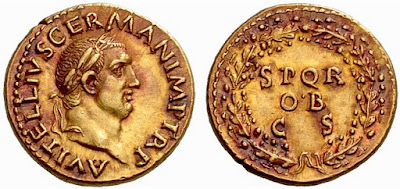“Boscoreale
treasure” is the name given to a great collection of silver and gold objects
(including many coins) discovered in the ruins of an old country villa near
Pompeii. The villa belonged to a rich family amd was buried by the volcanic
eruption of Vesuvius in 79 AD.
The villa
was excavated during several archaeological campaigns. It was discovered in
1876, but it was only in April 1895 that the remains of a vaulted box
containing the treasure, hidden in the wine press room, were discovered.
The
treasure is composed of more than a hundred pieces of exquisite silver (cups, jars and other containers, all finely decorated), some jewels and more
than a thousand aurei. Its content clearly shows the wealth of the owners of
the villa.
 |
| Boscoreale's Silver Treasure Tableware at the Louvre Museum |
The
excavation of the villa was undertaken by the landowner, Vincenzo de Prisco,
who set out to take advantage of his find. As a result, most findings were secretly sold outside Italy before the composition of the
treasure could be accurately recorded. The Baron Edmond de Rothschild was one
of the main buyers. He donated his purchases to the Louvre in 1896. Other
pieces came to the British Museum. A good part of the coins was dispersed
between collectors of all Europe and appear today regularly in auctions all
over the world.
The exceptional reddish aurei
The coins
from the Bocoreale treause are exceptional for several reasons. The great
majority of the pieces seem to have practically not circulated, so the treasure
contained some fantastic uncirculated aurei that are among the best known for
the reigns of Nero, Vespasian and Titus from which most coins dated.
Buried in
lava for one thousand eight hundred years, the intense initial heat and the
sulfurous content of the soil gave to all the gold coins a marked reddish
tonality that is unique for imperial aurei.
It is usual
that in modern auction catalogs every Roman aureus from the period with a
reddish tone is attributed to this treasure. It is also common for collectors
to pay a premium for possessing these coins over others that lack this tone.




No comments:
Post a Comment